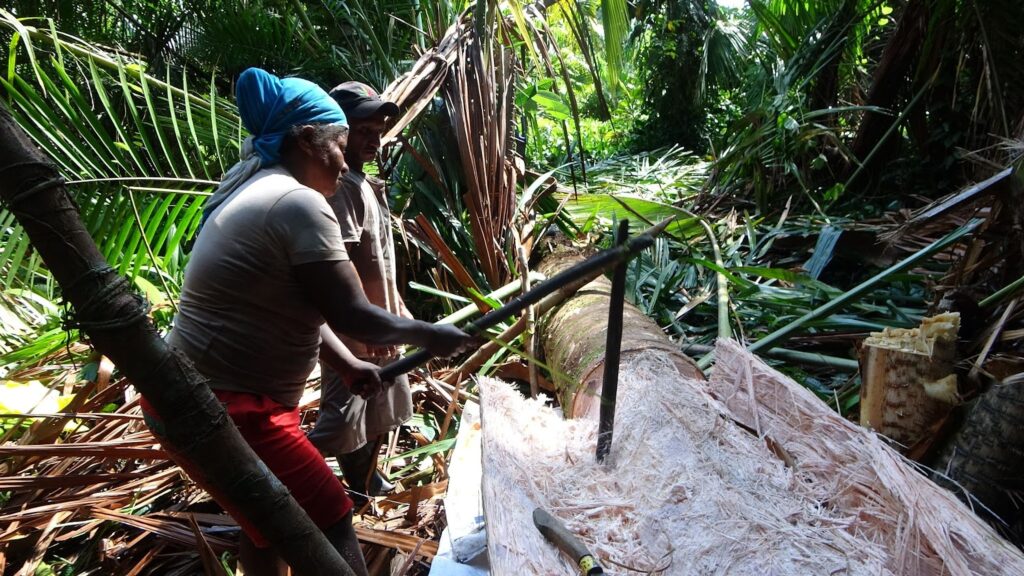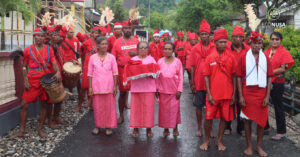In Papua, sago is more than just a plant—it is the lifeblood of the land. In a region rich in biodiversity and cultural heritage, sago stands as a symbol of harmony between humans and nature. For the Indigenous peoples of Papua, particularly in South Sorong, Southwest Papua, sago is not only a staple food. The sago forest—locally known as dusun sagu—is a sanctuary for wildlife, a storehouse of medicinal plants, a source of livelihood, and a sacred space where ancestral spirits dwell.
From a cosmological perspective, sago is part of the soul. It is a source of life and a marker of cultural identity. In various customary ceremonies, sago is always present as a symbol of unity and harmony. From traditional feasts and ceremonial greetings for honored guests to harvest celebrations, sago is prepared in many forms, such as papeda or sago wrapped in leaves, to express gratitude for the earth’s bounty.
Also read: Sago, the Miracle Plant Threatened by Development

Sago has given rise to a set of rich traditions passed down across generations. One of them is tokok sagu—the process of manually extracting fine sago flour from tree trunks. Another is harvesting sago grubs, an important source of protein and a culinary delicacy unique to Papua.
Kais Sago Forest Ecotourism
The harmony between the sago forest and Indigenous communities is now being offered through an authentic and immersive ecotourism experience called Kais Sago Ecotourism, located in Vabamure hamlet, Kais District, South Sorong Regency. This is more than just a forest adventure—it is a journey into the ecological and cultural values deeply rooted in each towering sago tree, as well as an exploration of traditional wisdom that nurtures the forest and sustains community life.
The sago forest—called mugu aubu in the Kais language—is essentially the daily living space of the local Indigenous community. It serves as a natural supermarket, where people “shop” for everything they need. Here, they gather sago as a staple food, hunt wild game like deer and boar, and fish for shrimp and river fish. Between the sago trunks grow medicinal plants used in traditional healing. The sago plant also provides building materials: the leaves are woven into roofing, the fronds used for walls, and the trunks often made into footbridges. Also read: Sustaining the Sago Bank in Manelek Village
How to Reach Kais Sago Forest Ecotourism
To reach the forest, the journey starts from Sorong City to Teminabuan in South Sorong, about 4–5 hours by car. From Teminabuan, visitors must take a motorized canoe for roughly 3 hours, passing through wide and narrow rivers flanked by dense sago, mangrove, and nipa palm forests. Along the way, wildlife can often be seen between the thick foliage.
Fishing activity (batanguh kali), traditionally performed by women. (EcoNusa Foundation/Simon Tabuni)
Activities in the Kais Sago Forest
Upon arrival, visitors are greeted by a serene, pristine landscape filled only with the sounds of birdsong and the gentle murmur of a winding stream. Guests can join the locals in processing sago—from tree felling and flour extraction to cooking papeda served with yellow fish broth or freshly caught river shrimp. Curious visitors are welcome to ask about the different varieties of sago and how the locals distinguish one from another. Local forest fruits are also offered for tasting.
Also read: Sago Forests Threatened by Oil Palm Expansion
Visitors can also learn how to make black salt from nipa palm fronds. Unlike sea salt, this traditional salt is produced through the burning of nipa palm parts—a rare, centuries-old tradition now fading from practice. Other activities include weaving koba-koba mats and umbrellas from sago leaves, and crafting sero—a traditional fish trap made from the sago tree’s internal stalks (tulang gaba) for sustainable fishing. Women often invite guests to join in batanguh kali, a traditional method of catching fish in shallow streams at low tide.
Cultural Performances and Wildlife Exploration
At dawn or dusk, guests can take a traditional canoe ride along the river, observing endemic birds such as cockatoos, parrots, crowned pigeons (mambruk), and maleo birds perched among the sago canopies. In some areas, bats flit between treetops, deer appear along the banks, and even cassowaries may cross paths. Evening cultural performances—featuring music and traditional dance in the village square—are more than just entertainment; they are expressions of the values and life philosophy of the Kais people, who live in deep connection with the sago forest.
Also read: Sago as a Lifeline for the Communities Around Lake Sentani
What makes this destination special is not just its natural beauty or biodiversity, but its profound cultural significance. Kais Sago Ecotourism opens up sustainable economic opportunities for the local community—ranging from tour guides and cooks to artisans and river transport operators—while also serving as a vehicle for environmental and cultural preservation.
To explore Kais Sago Ecotourism, contact wisatasagukais@gmail.com or visit their Instagram at @wisatasagukais.




